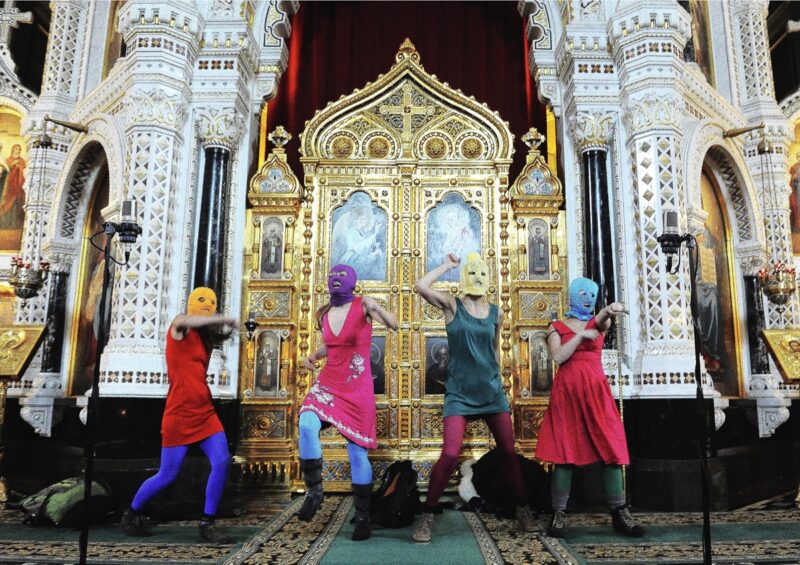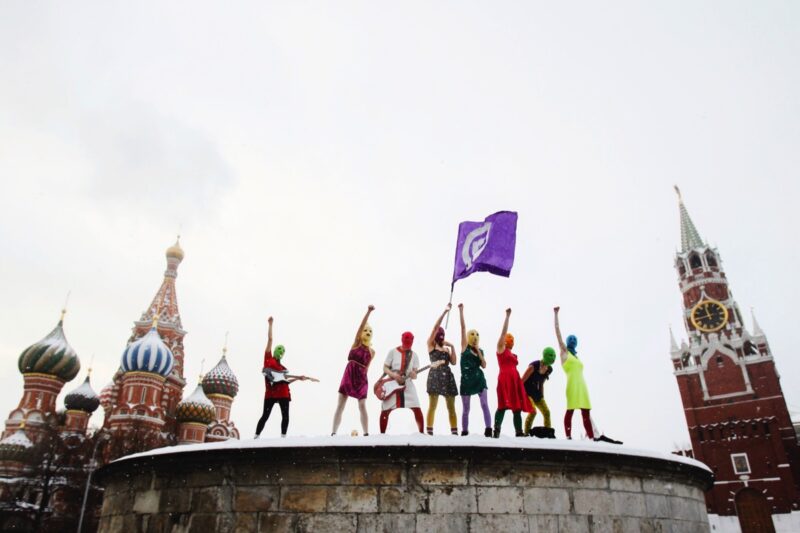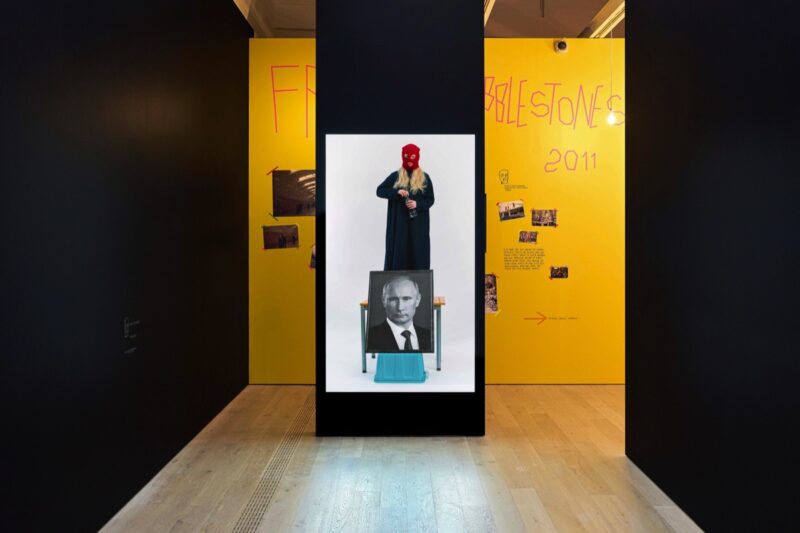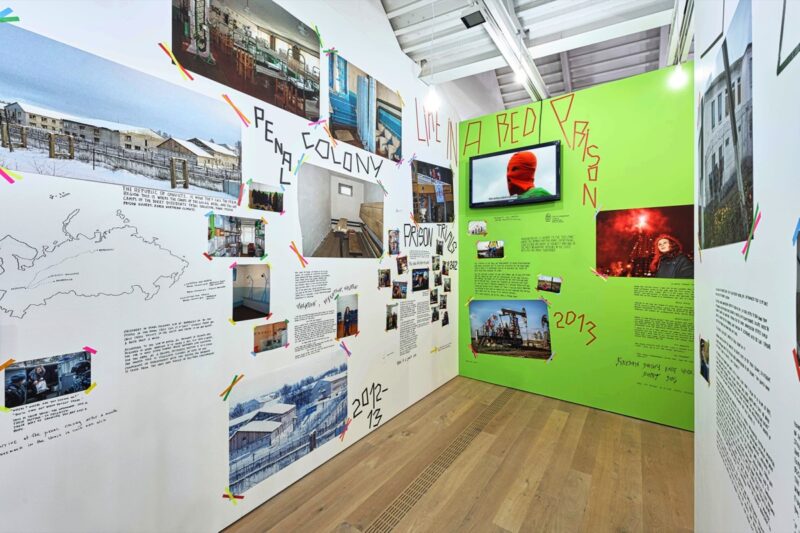[Fall 2024]
Velvet Terrorism
by Kelly Midori McCormick
[EXCERPT]
In the winter of 2012, eight women wearing bright tights, colourful above-the-knee dresses, and brilliant balaclavas climbed up the Lobnoye Mesto platform in Red Square, Moscow, and scream-sang the punk-rock ballad “Putin Peed his Pants” as snow fell around them. In what has become one of the best-known photographic documents of their work, the members of Pussy Riot can be seen raising bare arms and fists to the sky as they yell “Riot in Russia – Putin Peed his Pants! Riot in Russia – we exist!”
As Pussy Riot shares its work across Canada1 in 2024 in the exhibition Velvet Terrorism: Pussy Riot’s Russia and the punk show Riot Days, its examples of how everyday citizens can challenge authoritarian regimes form a bright spot amidst the ongoing war between Russia and Ukraine. One of the first things that visitors to the exhibition at The Polygon Gallery see is footage of Pussy Riot member Taso Pletner in a long black dress and red balaclava chugging a bottle of water as she stands on a table over a large black-and-white portrait of Putin, then lifting her skirt to bare her genitals and pee all over his portrait, her urine soaking his image. The radical act of baring a vulva to the world to desecrate an official image sets the tone for the experience of entering the world of Pussy Riot.
Visitors to the exhibition are asked to bear witness to the recent history of repression of Russian civil freedoms told through Pussy Riot’s repeated protest actions. Through documentation of the Russian state’s responses to its performance art, we witness the chipping away of civil rights and the increasingly creative strategies that members of the group use to look for ways to poke a finger in the eye of the Russian police. Pussy Riot’s provocative ethos comes through in its own grammar of documentation in which all materials in the gallery are treated with equal irreverence. Photographs and drawings are pasted, mixed, and collaged, and a unique symbology is developed through the wall text written with coloured tape, in block-letter handwriting, and through stylized Sharpie tags. The writing styles change and the perspective shifts through the timeline of each action, but the writer is anonymized even as each section is “signed” by the members involved in the specific action.
In a context in which protest can mean imprisonment, beating, poisoning, and forced labour, these women constantly challenge the barriers of the possible, and they do so with a cheeky sense of humour that energizes them as they navigate the court system and endure two years of imprisonment and house arrest. We viewers were not there in person to see Pussy Riot infiltrate the Cathedral of Christ the Saviour in Moscow and sing their “Punk Prayer” (“Shit, shit, holy shit! Virgin Mary, Mother of God, Be a feminist!”). But in fact, many of the actions were performed not for a large live audience but with the intention of capturing them on video and in photographs, not to depict a single instance of radical protest but to demonstrate how their actions are the culmination of the growing discontent across Russia.
The sense of unrest grows as we watch each action unfold in the maze-like space of the gallery: the women are battered and bruised as they perform “Putin will Teach You to Love the Motherland” at the 2014 Sochi Olympics; they hang banners to protest imprisonment of opposition leaders and the Ukrainian director Oleg Sentsov (2018); they storm the pitch at the FIFA World Cup final (2018); they hang rainbow flags from prominent government buildings to protest the criminalization of the Russian LGBTQ community (2020); and with each action we mourn and cheer for them.
This seminal retrospective of Pussy Riot’s work is an example of the number of people necessary to produce, record, and display collective art practices. Created by Pussy Riot member Maria Alyokhina in collaboration with the artist-run gallery and collective Kling & Bang in Reykjavik and curated by Ragnar Kjartansson, Ingibjörg Sigurjónsdóttir, Dorothée Kirch, and Reid Shier (The Polygon Gallery), the exhibition works on multiple sensorial fronts to show the viewer why Pussy Riot came into existence and how “anyone can be Pussy Riot.” In its broad scope of presenting artist actions against the Russian state, the exhibition also demonstrates how Pussy Riot is not only those in front of the camera but those behind it. Vasily Bogatov has been meticulously documenting the group’s actions since its early iteration as Voina, and he produced the documentary film Pussy Versus Putin (2013) as a member of the film collective Gogol’s Wives. The individual identity of each artist, curator, cinematographer, and photographer involved in every stage of Pussy Riot’s actions matters less, however, than does the total collective message of what happens when people come together to express their rights and defy the state.
In 2024, as Pussy Riot tours from Iceland to Denmark, to Germany, to Canada, it accompanies the exhibition with Riot Days, an “activist multimedia experience” performed as a “electronic punk opera” at local venues with proceeds benefitting a Ukrainian hospital. Whether we scream along with them or laugh as they hoodwink the police yet again, these exuberant performances engage and empower us to think of ways that we, too, might break the silences of the systems of repression that we live within.
[ Complete issue, in print and digital version, available here: Ciel variable 127 – SISTERS, FIGHTERS, QUEENS ] [ Complete article in digital version available here: Velvet Terrorism]
NOTES
1 The first stop was at the Musée d’art contemporain de Montréal, from October 23, 2023, to March 10, 2024.




